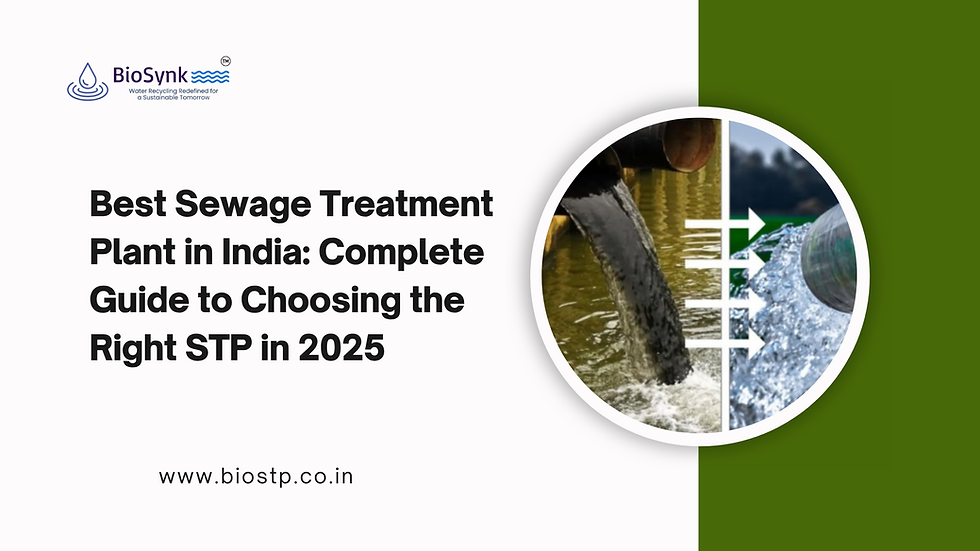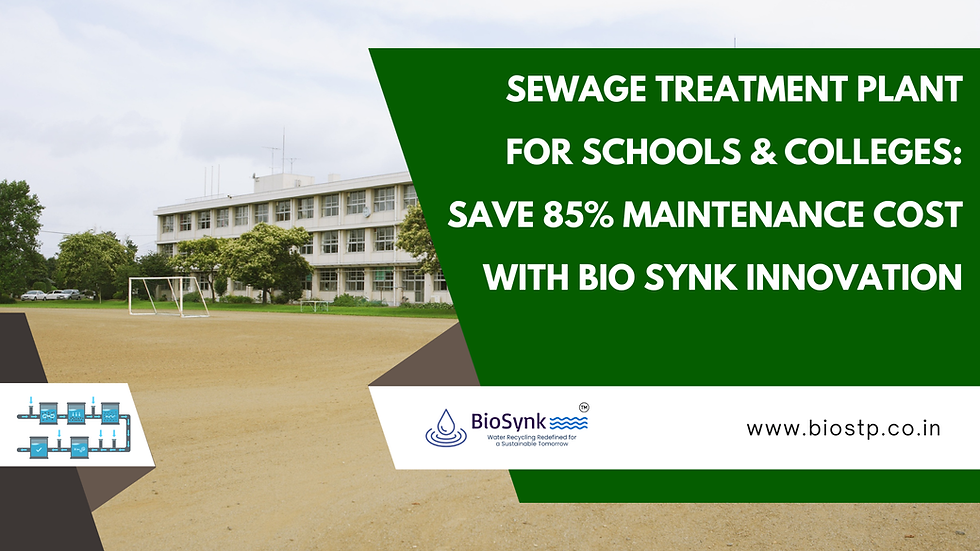Best Sewage Treatment Plant in India: Complete Guide to Choosing the Right STP in 2025
- MARKETING BIOSYNK
- Aug 9
- 3 min read

Introduction: Why Choosing the Right STP Matters More Than Ever
In 2025, wastewater management is no longer a background process-it is a critical environmental and compliance responsibility for every residential community, commercial complex, and industrial facility in India. With rising urban populations, rapid industrialization, and stricter regulations from the Central Pollution Control Board (CPCB) and State Pollution Control Boards (SPCBs), the demand for the best sewage treatment plant is at an all-time high.
A well-designed STP not only ensures regulatory compliance but also protects natural water bodies, conserves resources through treated water reuse, and safeguards public health. In this guide, we’ll cover everything you need to know to choose the right STP for your needs-whether you are a housing society, a manufacturing unit, or a government project.
1. What is a Sewage Treatment Plant (STP)?
A Sewage Treatment Plant is an engineered facility designed to treat wastewater from households, commercial spaces, or industries so that it meets discharge standards before being released or reused. The process generally involves:
Primary Treatment – Removal of solids and grit through screening and sedimentation.
Secondary Treatment – Biological processes like aerobic or anaerobic digestion to remove organic matter.
Tertiary Treatment – Advanced filtration, UV disinfection, or chlorination to remove remaining pathogens and pollutants.
Modern Bio STPs use eco-friendly microbial solutions and energy-efficient designs to minimize operational costs and environmental impact.
2. The Growing Need for the Best STP in India
India generates over 72,000 MLD (million litres per day) of sewage, but less than 30% is effectively treated. This leads to contamination of rivers, lakes, and groundwater, causing widespread health issues and environmental degradation.Government bodies now mandate STP installation for:
Residential complexes with more than a certain number of units.
Commercial buildings like malls, hotels, and IT parks.
Industries generating wastewater.
The best sewage treatment plant today must not only meet CPCB norms but also ensure minimal downtime, low power usage, and long-term operational stability.
3. Key Features of the Best Sewage Treatment Plant
When searching for the best STP, look for these critical features:
CPCB & SPCB Compliance – Ensures you avoid penalties and shutdowns.
Low Energy Consumption – Modern systems use blowers, pumps, and automation to reduce operational costs.
Odour Control – Advanced ventilation and bio-filtration eliminate foul smells.
Compact Footprint – Ideal for urban projects with space constraints.
Treated Water Reuse – Saves fresh water by enabling reuse for gardening, flushing, and cooling towers.
Automation & Remote Monitoring – Reduces manpower needs and improves reliability.
4. Types of Sewage Treatment Technologies in India
a. Conventional Activated Sludge Process (ASP)
Widely used but requires more space and energy.
b. Moving Bed Biofilm Reactor (MBBR)
Compact, efficient, and low-maintenance-ideal for housing societies.
c. Sequential Batch Reactor (SBR)
Handles varying load efficiently; produces high-quality treated water.
d. Membrane Bioreactor (MBR)
Premium choice for industries requiring ultra-pure discharge.
e. Bio STP
Eco-friendly, chemical-free treatment using beneficial microbes, with low sludge generation.
5. Cost Factors for the Best STP
The cost of an STP depends on:
Capacity (KLD) – Higher capacity requires larger infrastructure.
Technology Used – MBR is costlier but more efficient.
Automation Level – More automation increases initial cost but lowers running cost.
Site Conditions – Space, accessibility, and soil type can affect construction expenses.
A well-planned Bio STP offers the best balance of cost, performance, and sustainability.
6. Compliance and Approvals
A major advantage of choosing a reputed manufacturer like Bio Synk is smooth facilitation of CPCB and SPCB NOC approvals. Compliance is not optional-violations can result in heavy fines, legal action, or business closure.
7. Why Bio STPs Are the Smart Choice in 2025
Eco-Friendly – No harmful chemicals; supports biodiversity.
Lower Operational Costs – Reduced power and manpower needs.
Long Life Span – Robust construction with minimal wear and tear.
Reusability – Treated water meets standards for non-potable reuse.
Scalability – Easy to upgrade as demand grows.
8. Choosing the Right STP for Your Needs
Ask yourself:
How much sewage do we generate daily (KLD)?
Is space limited?
Do we want fully automated operations?
Will we reuse the treated water?
By matching your needs with the right technology, you ensure long-term savings and reliable performance.
9. Let’s Build a Cleaner India, Together
If you are looking for the best sewage treatment plant in India-one that is CPCB-compliant, eco-friendly, cost-effective, and future-ready-Bio Synk is here to help.Our Bio STP solutions are designed for housing societies, commercial complexes, and industries, with end-to-end support from design to installation and NOC approvals.Together, we can turn wastewater into a valuable resource and protect India’s precious water bodies.




Comments